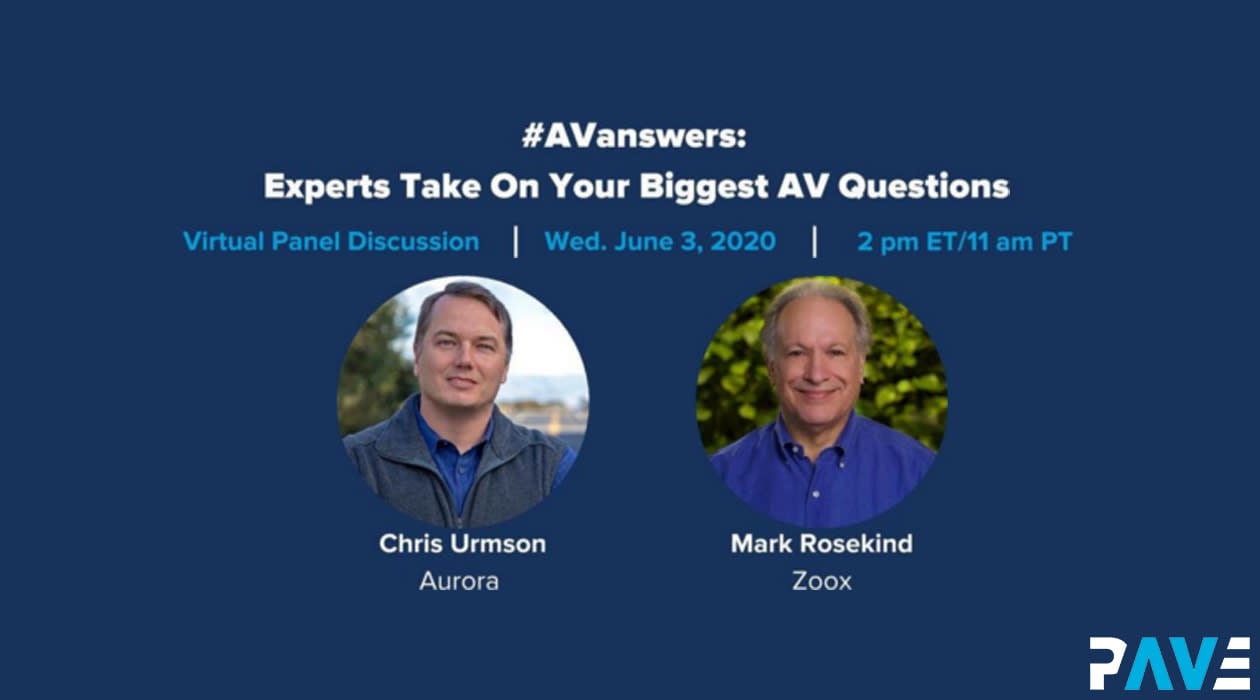What we learned when our CEO Chris Urmson and Zoox’s Mark Rosekind discussed the future of AVs
From our leaders | June 11, 2020 | 3 min. read

Are we there yet?
Last week, our CEO Chris Urmson, and Zoox’s Mark Rosekind joined PAVE — Partners for Automated Vehicle Education — for a virtual panel to discuss several of the big questions about self-driving cars. As a founding member of the organization, we take pride in educating the public about the importance of self-driving technology since the benefits have the potential to impact thousands of people, if not millions. Below, and with a couple of edits for clarity, are the most impactful things we learned from Chris and Mark when they discussed topics that ranged from safety to timelines to mythbusters and everything between.
Safety is not something that you bolt on at the end.
When one of the biggest impacts you can have with this technology is to challenge the status quo and save the 36,000 lives that are lost on American roads every year, you have to embed that mindset in your organization early on.
Safety delayed is safety denied.
We need to be careful and thoughtful about the risk threshold that we accept with self-driving technology. We obviously want to drive the status quo to zero deaths over time, but not at the expense of the incremental lives we could save.
It’s not when self-driving cars will be here — it’s how they’ll be here.
There are two sets of people: one that believes AVs are here and you can buy one today — and a second that believes AVs will never be here. Both are wrong.
If you go to Phoenix today, you’ll see that my old team at Google has vehicles, with no driver, in a fixed community helping people get to where they want to go. The question then becomes: how do we expand from these initial forays into services accessible to more people, and with vehicles that can deal with more complicated traffic and weather environments, higher speeds, etc.?
In the next 10, 20, 50 years, this technology will germinate from seeds into something that is ubiquitous and yields incredible social benefits around safety and improved access at a lower cost.
It is dangerous when advanced driver-assistance systems (ADAS) are branded as self-driving.
The promise of self-driving technology has captured the public’s imagination. Unfortunately, when some driver assistance systems are branded with misleading words, they can generate confusion around whether they’re assisting or actually driving for you. Driver assistance is great, it will save lives and make driving tremendously easier for people, but it’s very different than self-driving vehicles. The distinction is important.
This is a transformative moment in transportation.
Unlike other technologies that are made out of sight in a lab, we as a nation, community, and world have the awesome opportunity to see this technology be developed since so much of the work happens on public roads in our cities. We haven’t had such a transformative moment in transportation since the introduction of the car. I hope it feels exciting for people to start imagining what the future will look like.
Building and delivering this technology is extremely challenging.
We’re not building this technology for technology’s sake — and, we’re trying to make it actually work in and for the world. However, relative to developing a web application or even a consumer electronics product, the scope of work that we have to tackle is massive.
To develop this technology, we have to figure out and be good at optimizing the electronics of the vehicle’s sensors (cameras, lidar, and radar), the high-speed computing and networking that happens in the vehicles, and the software infrastructure that allows us to make real-time decisions. Then, there’s the complexity of interpreting the signal that’s coming back from our sensors, so that our software can generate a model of the world. Then, we predict how that model will evolve over the next few seconds so we can then pick a safe path through it, and then translate that into something the vehicle can understand.
On top of this, we’re driving a multi-ton thing through the world, and we need to be doing that all at a very high level of reliability, robustness, and safety. Then, we get into the challenge of building the right business models to make the technology useful. It’s kind of the classic problem of “a chain is only as good as its weakest link.” And we have a long chain.
This pandemic amplifies the benefits of self-driving.
This pandemic hasn’t changed the thesis of why Aurora and this technology is so important. If AVs had been available during this pandemic, we could have augmented our supply chains to make it easier for people to get places without the risk of transmission. Now, I would say there’s even more clarity about the benefits of and the demand for this technology.
Delivering the benefits of self-driving technology safely, quickly, and broadly.